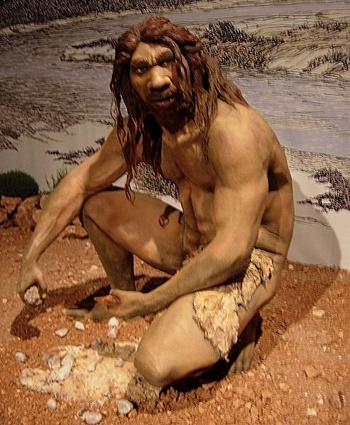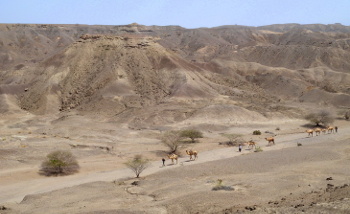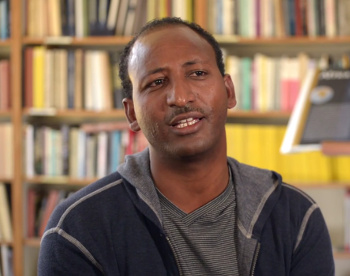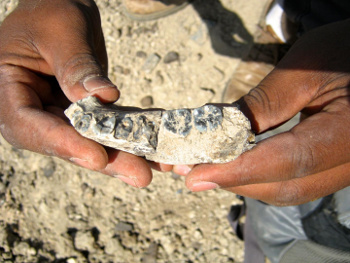The Earliest Homo
April 23, 2015
People are usually
curious about their
ancestors. I was told a few stories about my
grandparents, and my
wife was told an impressive number of stories about her distant
relatives. My grandparents were born at about the time that
Heinrich Hertz demonstrated the existence of
radio, and
decades before the
Wright brothers demonstrated
human flight.
Unless you're from some renowned
family, the trail of your ancestors is usually gone after just three, or four,
generations. After that, our
history is dissolved into the life stories of the many people who have lived before us. We can somewhat relate to the life stories of people in
ancient texts, such as the
Old Testament. According to
James Ussher, such tales go back as far as about
six millennia from the present.
With advances in methods of
radiometric dating and
paleoanthropology, we have a good idea of how far back we can claim our existence as a
species,
Homo sapiens. We are just one species of the
genus,
Homo, that includes such memorable characters as
Homo erectus, who lived as early as 1.9 million years ago;
Homo habilis, who lived as early as 2.8 million years ago; and,
Homo neanderthalensis, who lived as early as 350,000 years ago.

I think his music was popular in the 1990s.
This is an artistic rendering of the appearance of a male of the species, Homo heidelbergensis, which dates back at least 600,000 years.
Neanderthals and modern humans are descendants of Homo heidelbergensis, with Homo sapiens appearing about 130,000 years ago.
Photograph by Jose Luis Martinez Alvarez, via Wikimedia Commons.)
Paleoanthropologists are still digging up evidence (pun intended) of man's early origins; and, just as in much of
science,
luck plays a large part in their discoveries. This was the case for the recent find of an ancient Homo
mandible in the
Afar region of
Ethiopia.[1-5] This mandible, which is the the lower
jaw holding the lower
teeth, was dated to be 2.8 - 2.75 million years old. This date is 400,000 years earlier than that of other
fossils of the Homo
lineage.[5] Discovered with this mandible were other fossils between 2.84 and 2.58 million years old that aid in a reconstruction of this Homo's
environment.[2]
This fossil, designated the LD 350-1 Homo mandible, was discovered and analyzed by a huge international team from the
University of Nevada Las Vegas (Las Vegas, Nevada),
Arizona State University (Tempe, Arizona),
Pennsylvania State University (University Park, Pennsylvania),
George Washington University (Washington, DC),
University College London (London, UK), the
Authority for Research and Conservation of Cultural Heritage (Addis Ababa, Ethiopia),
CNRS Géosciences Rennes (Rennes, France), the
Berkeley Geochronology Center (Berkeley, California), the
Leibniz Institute for Evolution and Biodiversity Science (Berlin, Germany), the
Richard Stockton College of New Jersey (Galloway, New Jersey), the
University of California (Berkeley, California), and the
Swedish Museum of Natural History (Stockholm, Sweden).

Photograph of the area of the Afar Regional State of Ethiopia in which the fossil Homo mandible was found.
(Pennsylvania State University photo by Erin DiMaggio.)
The mandible was found in the Ledi-Geraru area of Ethiopia where
faults have exposed layers of fossil-bearing
sedimentary rock.[4] This
research project was started in 2002 to examine the same area where the "
Lucy" fossil was found.[5] Lucy was a more
apelike creature of the species,
Australopithecus afarensis, that lived 3.2 million years ago. Thirteen years into the project, team member and Arizona State University
graduate student,
Chalachew Seyoum, found the fossil.[5] Says Seyoum,
"I had good experience in field surveying and knew where potential sediments are. I climbed up a little plateau and found this specimen right on the edge of the hill."[5]

Chalachew Seyoum, the Arizona State University graduate student who discovered the Homo mandible.
(Still image from an Arizona State University video.)
Since it wasn't possible to date the fossil mandible directly, dating was established by
radiometric analysis of
volcanic ash layers above and below the specimen. The
argon-40/argon-39 method determines the age of the volcanic ash through the
isotope ratios.[4] Says
Erin DiMaggio, lead
author of one paper on this study and a
research associate in the
Penn State Department of Geosciences, "We used multiple dating methods including radiometric analysis of volcanic ash layers, and all show that the hominin fossil is 2.8 to 2.75 million years old."[4]
This find connects a lineage between Lucy, a member of the more apelike Australopithecus afarensis, and Homo fossils dated to 2.3 million years and younger.[5] The mandible has both primitive and more modern traits, including advanced features such as slim
molars,
symmetrical premolars and an
evenly proportioned jaw. However, it does have the primitive, sloping
chin present on Australopithecus afarensis.[1,3,5] It's thought that the creature associated with the mandible
walked on two legs, and research is still in progress to determine whether it would have used
stone tools.[5]

2.8 Mya Homo mandible photographed near its discovery site.
(Arizona State University photo by Brian Villmoare.)
Examination of other
vertebrate fossils of the same period indicates a
habitat of mixed
grasslands and
shrub lands with
forested areas and
trees lining
rivers or
wetlands.[2] Fossils found in the area include prehistoric
antelope and
elephant,
a type of hippopotamus,
crocodile and
fish.[4] The environment was probably like that of the
Serengeti Plains or the
Kalahari, and it's thought that
global climate change at the time resulted in
evolutionary changes in many
mammals, including hominin.[4]
The
Ledi-Geraru Research Project is funded by the
National Science Foundation, the
American Association of Petroleum Geologists, the
Society for Sedimentary Geology, and the
Geological Society of America, among others. [4-5]
References:
- Brian Villmoare, William H. Kimbel, Chalachew Seyoum, Christopher J. Campisano, Erin DiMaggio, John Rowan, David R. Braun, J. Ramon Arrowsmith, and Kaye E. Reed, "Early Homo at 2.8 Ma from Ledi-Geraru, Afar, Ethiopia," Science, Advanced Online Publication, March 4 2015, DOI: 10.1126/science.aaa1343.
- Erin N. DiMaggio, Christopher J. Campisano, John Rowan, Guillaume Dupont-Nivet, Alan L. Deino, Faysal Bibi, Margaret E. Lewis, Antoine Souron, Lars Werdelin, Kaye E. Reed2, and J. Ramón Arrowsmith, "Late Pliocene fossiliferous sedimentary record and the environmental context of early Homo from Afar, Ethiopia," Science, Advanced Online Publication, March 4 2015, 10.1126/science.aaa1415.
- Ann Gibbons, "Deep roots for the genus Homo," Science, vol. 347, no. 6226 (March 6, 2015), pp. 1056-1057, DOI: 10.1126/science.347.6226.1056-b.
- A'ndrea Elyse Messer, "Earliest known fossil of the genus Homo dates to 2.8 to 2.75 million years ago," Pennsylvania State University Press Release, March 4, 2015.
- Discovery of jaw by ASU team sheds light on early human ancestor, Arizona State University Press Release, March 4, 2015.
Permanent Link to this article
Linked Keywords: Curiosity; curious; ancestor; grandparent; wife; kinship; relative; Heinrich Hertz; radio; decade; Wright brothers; human flight; family; generation; history; ancient history; text; Old Testament; James Ussher; Ussher chronology; radiometric dating; paleoanthropology; species; Homo sapiens; genus; Homo; Homo erectus; Homo habilis; Neanderthal; Homo neanderthalensis; music; 1990s; artistic rendering; male; Homo heidelbergensis; anatomically modern human; Homo sapiens; Jose Luis Martinez Alvarez; Wikimedia Commons; paleoanthropology; Paleoanthropologist; science; serendipity; luck; human mandible; Afar region; Ethiopia; jaw; teeth; fossil; lineage; environment; University of Nevada Las Vegas (Las Vegas, Nevada); Arizona State University (Tempe, Arizona); Pennsylvania State University (University Park, Pennsylvania); George Washington University (Washington, DC); University College London (London, UK); Authority for Research and Conservation of Cultural Heritage (Addis Ababa, Ethiopia); CNRS Géosciences Rennes (Rennes, France); Berkeley Geochronology Center (Berkeley, California); Leibniz Institute for Evolution and Biodiversity Science (Berlin, Germany); Richard Stockton College of New Jersey (Galloway, New Jersey); University of California (Berkeley, California); Swedish Museum of Natural History (Stockholm, Sweden); Afar Regional State; Erin DiMaggio; fault; sedimentary rock; research; Lucy; apelike; creature; Australopithecus afarensis; graduate student; Chalachew Seyoum; plateau; radiometric dating; radiometric analysis; volcanic ash; isotopes of argon; argon-40/argon-39; isotope analysis; isotope ratio; Erin DiMaggio; author; research associate; Penn State Department of Geosciences; molar; symmetry; symmetrical; body proportion; chin; gait; stone tool; Brian Villmoare; vertebrate; habitat; grassland; shrub land; forest; tree; river; wetland; antelope; elephant; hippopotamus; crocodile; fish; Serengeti Plains; Kalahari; global climate change; evolution; evolutionary; mammal; Ledi-Geraru Research Project; National Science Foundation; American Association of Petroleum Geologists; Society for Sedimentary Geology; Geological Society of America.